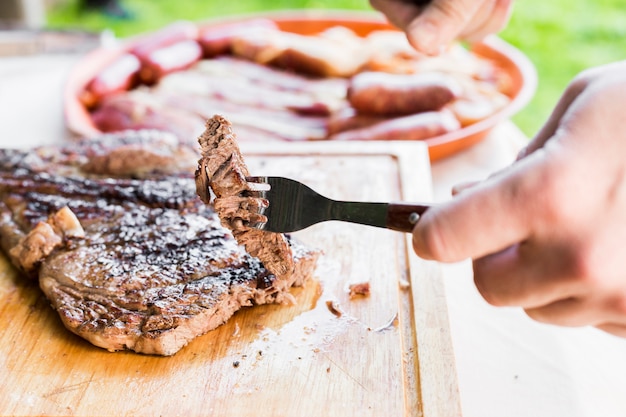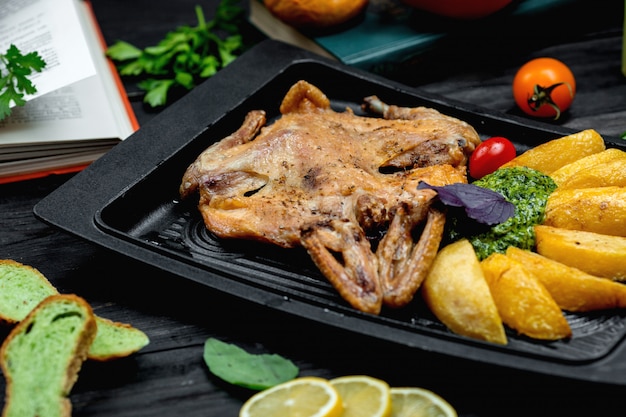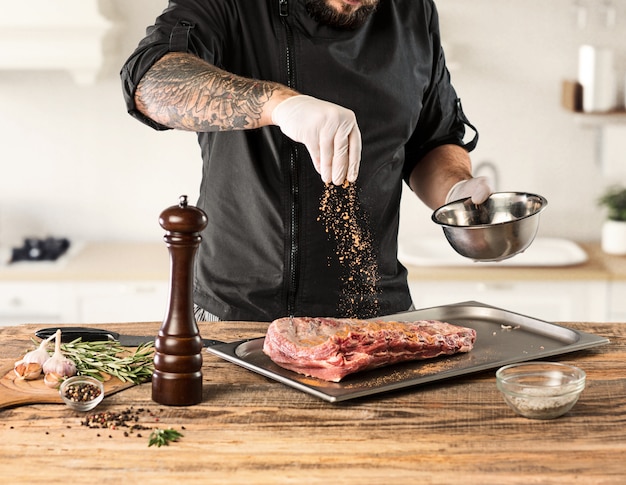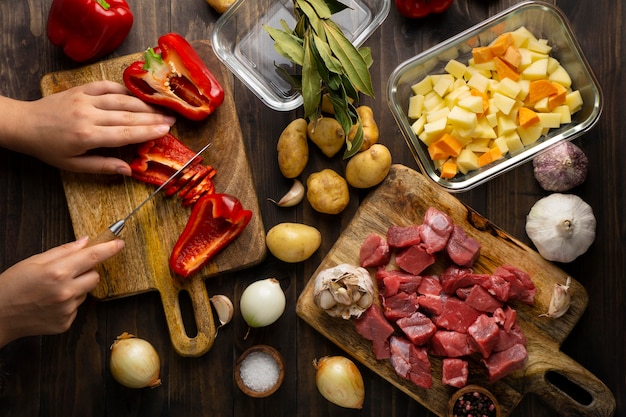For years, I've dreamt of a perfectly cooked prime rib roast - the kind you see in fancy restaurants, with a beautiful crust and juicy, melt-in-your-mouth meat. But being a busy single person, the idea of a whole roast seemed like a culinary Everest, way too much for one person. Then, I had a brainwave - why not scale it down? Why not conquer that culinary Everest in a more manageable, two-person size? It was a revelation! This simple guide is all you need to recreate that restaurant-worthy experience in your own kitchen.
Part 1: choosing the right cut – The Foundation of a Delicious Roast

The first step to a fantastic prime rib roast for two is choosing the right cut. Forget about those massive roasts you see at the supermarket, we're talking about a more intimate affair here - a small, well-marbled rib roast that's around 2-3 pounds. This size is just right for a couple of hearty meals, and it's perfect for cooking in a smaller oven or even on the stovetop.
1.1 The Butcher's Secret – Finding the Perfect Cut
I've discovered that the best way to get a perfect prime rib roast for two is to head to the butcher shop. These guys are the wizards of meat, and they're usually thrilled to help you find a specific cut that's ideal for your needs. They'll even trim it and tie it for you, ensuring it cooks evenly and looks beautiful on the table. I'll always champion the butcher shop experience; it's a real connection to the food, and you get personalized advice you won't find anywhere else.
1.2 Deciphering the Cuts – Choosing Your Prime Rib
Now, for the fun part – choosing the cut. There are a few contenders for a smaller roast, but I have a personal favourite that I'll readily recommend.
- standing rib roast: This is the most luxurious option. It usually has a bone on one side, which adds a touch of elegance to the table and helps the meat cook more evenly. It might be a little pricier, but trust me, the extra flavour and tenderness are worth the splurge.
- Rib Roast: A classic choice, Rib Roast is a delicious and affordable option. It’s a leaner cut than the Standing Rib Roast, but still incredibly flavorful.
- Rolled Rib Roast: This roast is a boneless cut, usually rolled for even cooking. It’s a good option if you want a more compact roast.
- Top Blade Roast: If you're looking for a leaner option, ask for a Top Blade Roast. This cut is perfect for slicing and serving as it cooks up quickly and beautifully.
No matter which cut you choose, make sure you chat with the butcher. They can offer tailored advice on how to cook your chosen cut for the most amazing results.
Part 2: Prepping the Roast – Getting Ready for Deliciousness

Now that you have your perfect cut of prime rib, it's time to prep it for its culinary journey. There are two main approaches here: dry-brining and wet-brining. Each method has its own unique advantages, so let's delve into both.
2.1 Dry Brining – The Easy and Flavorful Choice
Dry-brining is my go-to method. It's simplicity at its finest, and it delivers outstanding results. It involves simply rubbing the roast with salt and spices, letting the salt do its magic. This process draws out some of the moisture, but it also helps to flavor the meat and create a gloriously crispy crust.
The beauty of dry-brining is its effortless execution. You simply rub the roast with a good amount of kosher salt, making sure you cover it generously. Then, pop it in the fridge for at least 4 hours, and up to 24 hours. This allows the salt to penetrate the meat, enhancing its flavour and tenderness.
2.2 Wet Brining – Unlocking Juiciness and Depth of Flavor
Wet brining takes a slightly more hands-on approach, but it's a method that truly elevates the flavour and tenderness of the meat. It involves soaking the roast in a liquid brine, usually a mixture of water, salt, and spices. This technique helps to keep the meat moist and tender, and it also adds a deeper, more complex flavour.
Wet brining takes a bit longer, but the results are truly rewarding. Submerge the roast in the brine for at least 12 hours, and up to 24 hours. The longer it soaks, the more flavourful and tender it will become.
Part 3: Choosing Your Cooking Method – Classic and Modern Approaches

Now, it's time to choose your cooking method. There are a few options available, but I'm going to share my two favourites, each offering a unique journey to deliciousness.
3.1 oven roasting – The Classic Way to Prime Rib Perfection
Oven roasting is the most traditional way to cook a prime rib roast. It's simple, reliable, and it always delivers a beautifully cooked roast, with a lovely crispy crust and perfectly cooked interior. The secret lies in mastering the oven temperature.
3.2 reverse searing – A Modern Twist for Tenderness and Juiciness
Reverse searing is a more recent technique that has taken the culinary world by storm. It involves cooking the roast at a low temperature for a longer period of time, which ensures a beautifully tender and juicy interior, and then searing it at a high temperature to create a delicious, crispy crust. It's a bit slower, but the results are truly exceptional.
Part 4: Preparing the Roast for Cooking – The Finishing Touches
Now that you've chosen your cooking method, it's time to get your roast ready. Whether you've dry-brined or wet-brined, it's crucial to bring the roast to room temperature before cooking. This helps it cook more evenly, preventing any cold spots. Also, make sure to pat the roast dry with paper towels before cooking. This will help it get a nice crispy crust.
4.1 Choosing the Right Oven Rack – Optimizing Even Cooking
For a smaller roast, I find it's best to use a lower oven rack. This helps ensure that the roast cooks evenly on all sides. Make sure there's enough space around the roast in the oven so it can cook properly.
4.2 Adding a Herb Rub – Elevate the Flavor
To amp up the flavour of your prime rib, I love adding a simple herb rub. In a small bowl, mix a few tablespoons of olive oil with salt, pepper, garlic powder, onion powder, and your favourite herbs. You can get creative with your blend - maybe some rosemary, thyme, or oregano? The possibilities are endless.
Part 5: Cooking the Prime Rib – Bringing Your Roast to Life
Now, the moment you've been waiting for – cooking the roast! Here's a breakdown of both oven roasting and reverse searing methods for a smaller prime rib roast.
5.1 Oven Roasting – The Classic Approach
For oven roasting, preheat your oven to 450°F (232°C). Place the roast on a roasting rack in a baking pan, ensuring it has enough space to cook evenly. Start by roasting for 15 minutes at this high temperature, which helps to create a beautiful sear on the outside of the roast. Then, reduce the oven temperature to 325°F (163°C). Cook the roast for 15 minutes per pound for medium-rare, 20 minutes per pound for medium, or 25 minutes per pound for medium-well.
Once the roast is cooked, resist the urge to carve it immediately. Let it rest for at least 15 minutes before carving. This gives the juices time to redistribute throughout the meat, resulting in a more tender and juicy roast.
5.2 Reverse Searing – The Modern Way
For reverse searing, preheat your oven to 275°F (135°C). Place the roast on a roasting rack in a baking pan. Now, let the magic happen - cook the roast for 2-3 hours, or until it reaches an internal temperature of 125°F (52°C) for medium-rare, 135°F (57°C) for medium, or 145°F (63°C) for medium-well.
Once the roast reaches your desired internal temperature, remove it from the oven and let it rest for at least 15 minutes. While the roast is resting, preheat a cast iron skillet or heavy-bottomed pan over high heat. This is where the sear comes in. Sear the roast on all sides for 2-3 minutes per side, or until it's nicely browned and crispy.
Let the roast rest for another 15 minutes before carving, allowing the juices to redistribute and the meat to relax, resulting in a truly incredible culinary experience.
Part 6: Checking for Doneness – Knowing When It's Perfect
To ensure your prime rib roast is cooked to your liking, a meat thermometer is your best friend. Insert the thermometer into the thickest part of the roast, making sure it doesn't touch the bone. Here's a handy guide to the internal temperatures for different levels of doneness:
| Doneness | Internal Temperature (°F) | Internal Temperature (°C) |
|---|---|---|
| Rare | 120-125 | 49-52 |
| Medium-Rare | 130-135 | 54-57 |
| Medium | 140-145 | 60-63 |
| Medium-Well | 150-155 | 66-68 |
| Well-Done | 160 | 71 |
I personally prefer medium-rare prime rib, but the perfect level of doneness is a matter of taste.
Part 7: Carving the Prime Rib – A Culinary Art Form
Once the roast has rested, it's time for the final act – carving. Use a sharp carving knife to slice the roast into thin, even slices. The key is to slice against the grain of the meat. This helps to make the slices tender and easy to chew, releasing the incredible flavors you've worked so hard to achieve.
7.1 Serve it Up – A Feast for the Senses
Serve your prime rib masterpiece with your favorite sides. I love to pair it with roasted vegetables, mashed potatoes, or a simple salad. For an extra touch of flavour, consider a sauce like horseradish sauce or au jus. Let the flavors dance on your palate!
Part 8: Leftovers – Making the Most of Your Prime Rib
If you have any leftover prime rib, don't despair! You can easily reheat it. Reheat the slices in a low oven or in a skillet on the stovetop. I love to make sandwiches with leftover prime rib. Pile those delicious slices onto a crusty roll with your favourite toppings for a truly satisfying lunch. You can also add the leftovers to a soup or stew for a comforting and flavourful meal.
FAQs
How long should I let the prime rib rest before carving?
Let your prime rib roast rest for at least 15 minutes before carving. This allows the juices to redistribute, resulting in a more tender and juicy roast.
What temperature should I cook my prime rib to for medium-rare?
For medium-rare, cook your prime rib to an internal temperature of 130-135°F (54-57°C).
Can I cook a prime rib roast on the stovetop?
Absolutely! You can cook a prime rib roast on the stovetop. You'll need a large skillet or dutch oven that can hold the roast. Sear the roast on all sides, then reduce the heat to low and cook until the roast reaches your desired internal temperature.
What are some good sides to serve with prime rib?
Prime rib is a versatile dish that pairs beautifully with a variety of sides. Some popular choices include roasted vegetables like asparagus, Brussels sprouts, and root vegetables, mashed potatoes, creamed spinach, and a simple green salad.
How long can I store leftover prime rib in the refrigerator?
You can store leftover prime rib in the refrigerator for up to 3-4 days.
I hope this guide helps you to cook the perfect prime rib roast for two! It's a delicious and impressive meal that's perfect for a special occasion or just a simple weeknight dinner. So, get out there, choose your cut, and give it a try! You'll be surprised how easy it is to create a culinary masterpiece for two.
Everyone is watching

Perfect Rice Every Time: The Ultimate Guide to Cooking Rice
Cooking TipsAs a self-proclaimed foodie, I've always been a bit obsessed with rice. It's the foundation of countless cuisi...

Ultimate Guide to Cooking the Perfect Thanksgiving Turkey
Cooking TipsThanksgiving. Just the word conjures up images of overflowing tables laden with delicious food, the scent of r...

The Ultimate Guide to Cooking Asparagus: Tips, Techniques, and Recipes
Cooking TipsAsparagus. The mere mention of this spring delicacy conjures up images of vibrant green spears, crisp and burs...

Can You Cook Spaghetti with Gasoline? (The Shocking Truth)
Cooking TipsWe've all seen those crazy internet trends. You know, the ones that make you wonder, "Did someone actually try...

Chorizo and Eggs Recipe: The Ultimate Guide
Cooking TipsRight, let’s talk about chorizo and eggs. You know, that classic Spanish dish that's always a winner. It's th...
